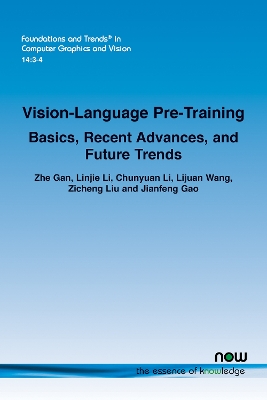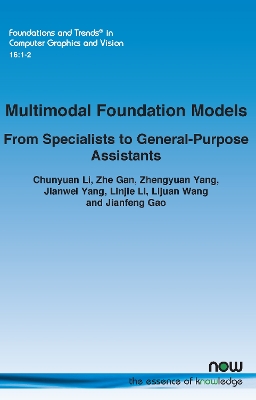Foundations and Trends® in Computer Graphics and Vision
2 total works
Vision-Language Pre-Training
by Zhe Gan, Linjie Li, Chunyuan Li, Lijuan Wang, Zicheng Liu, and Jianfeng Gao
Published 5 December 2022
Humans perceive the world through many channels, such as images viewed by the eyes, or voices heard by the ears. Though any individual channel might be incomplete or noisy, humans can naturally align and fuse information collected from multiple channels in order to grasp the key concepts needed for a better understanding of the world.
One of the core aspirations in Artificial Intelligence (AI) is to develop algorithms that endow computers with an ability to effectively learn from multimodal (or, multi-channel) data. This data is similar to sights and sounds attained from vision and language that help humans make sense of the world around us. For example, computers could mimic this ability by searching the most relevant images to a text query (or vice versa), and by describing the content of an image using natural language. Vision-and-Language (VL), a popular research area that sits at the nexus of Computer Vision and Natural Language Processing (NLP), aims to achieve this goal.
This monograph surveys vision-language pre-training (VLP) methods for multimodal intelligence that have been developed in the last few years. Approaches are grouped into three categories: (i) VLP for image-text tasks, such as image captioning, image-text retrieval, visual question answering, and visual grounding; (ii) VLP for core computer vision tasks, such as (open-set) image classification, object detection, and segmentation; and (iii) VLP for video-text tasks, such as video captioning, video-text retrieval, and video question answering. For each category, a comprehensive review of state-of-the-art methods is presented, and the progress that has been made and challenges still being faced are discussed, using specific systems and models as case studies. In addition, for each category, advanced topics being actively explored in the research community are presented, such as big foundation models, unified modeling, in-context few-shot learning, knowledge, robustness, and computer vision in the wild, to name a few.
One of the core aspirations in Artificial Intelligence (AI) is to develop algorithms that endow computers with an ability to effectively learn from multimodal (or, multi-channel) data. This data is similar to sights and sounds attained from vision and language that help humans make sense of the world around us. For example, computers could mimic this ability by searching the most relevant images to a text query (or vice versa), and by describing the content of an image using natural language. Vision-and-Language (VL), a popular research area that sits at the nexus of Computer Vision and Natural Language Processing (NLP), aims to achieve this goal.
This monograph surveys vision-language pre-training (VLP) methods for multimodal intelligence that have been developed in the last few years. Approaches are grouped into three categories: (i) VLP for image-text tasks, such as image captioning, image-text retrieval, visual question answering, and visual grounding; (ii) VLP for core computer vision tasks, such as (open-set) image classification, object detection, and segmentation; and (iii) VLP for video-text tasks, such as video captioning, video-text retrieval, and video question answering. For each category, a comprehensive review of state-of-the-art methods is presented, and the progress that has been made and challenges still being faced are discussed, using specific systems and models as case studies. In addition, for each category, advanced topics being actively explored in the research community are presented, such as big foundation models, unified modeling, in-context few-shot learning, knowledge, robustness, and computer vision in the wild, to name a few.
Multimodal Foundation Models
by Chunyuan Li, Zhe Gan, Zhengyuan Yang, Jianwei Yang, Linjie Li, Lijuan Wang, and Jianfeng Gao
Published 6 May 2024
This monograph presents a comprehensive survey of the taxonomy and evolution of multimodal foundation models that demonstrate vision and vision-language capabilities, focusing on the transition from specialist models to general-purpose assistants.
The focus encompasses five core topics, categorized into two classes; (i) a survey of well-established research areas: multimodal foundation models pre-trained for specific purposes, including two topics – methods of learning vision backbones for visual understanding and text-to-image generation; (ii) recent advances in exploratory, open research areas: multimodal foundation models that aim to play the role of general-purpose assistants, including three topics – unified vision models inspired by large language models (LLMs), end-to-end training of multimodal LLMs, and chaining multimodal tools with LLMs.
The target audience of the monograph is researchers, graduate students, and professionals in computer vision and vision-language multimodal communities who are eager to learn the basics and recent advances in multimodal foundation models.
The focus encompasses five core topics, categorized into two classes; (i) a survey of well-established research areas: multimodal foundation models pre-trained for specific purposes, including two topics – methods of learning vision backbones for visual understanding and text-to-image generation; (ii) recent advances in exploratory, open research areas: multimodal foundation models that aim to play the role of general-purpose assistants, including three topics – unified vision models inspired by large language models (LLMs), end-to-end training of multimodal LLMs, and chaining multimodal tools with LLMs.
The target audience of the monograph is researchers, graduate students, and professionals in computer vision and vision-language multimodal communities who are eager to learn the basics and recent advances in multimodal foundation models.

